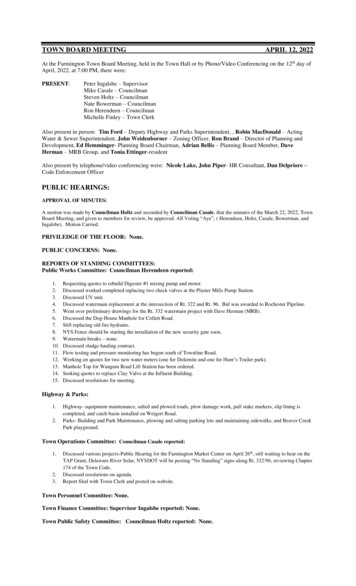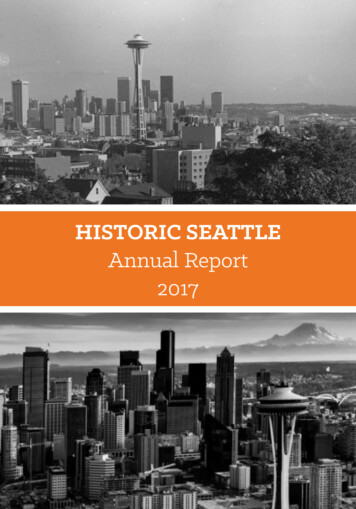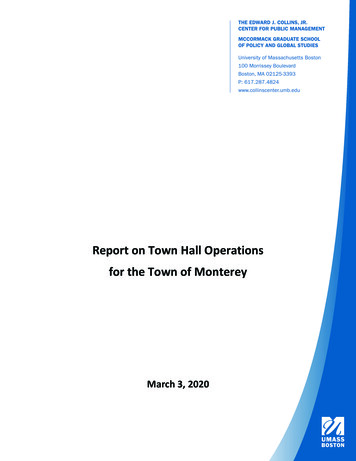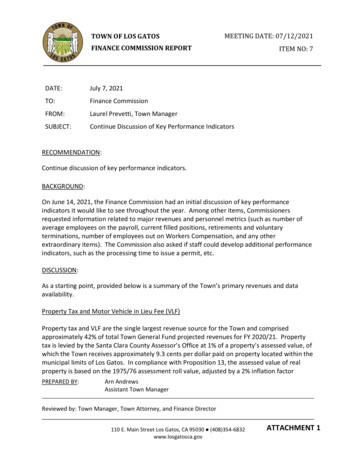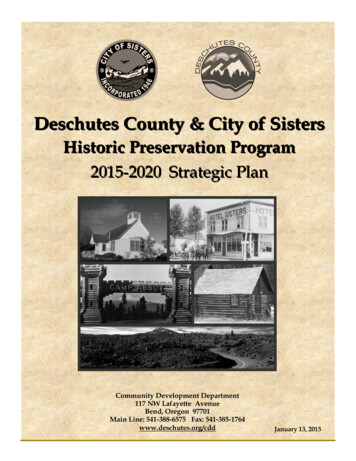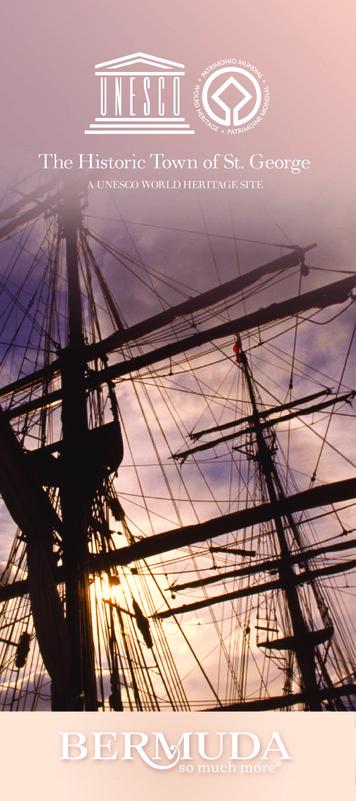
Transcription
The Historic Town of St. GeorgeA UNESCO WORLD HERITAGE SITE
Traffic FlowBus StopParks &Gardens StocChurch7Cemetery5Post Office Hillcrest Visitor InformationCentre Pharmacy Harbour 6View FerryAfrican DiasporaHeritage Trail S124BermudaNational Trust13 TuckerHouse Fortification/FortPark Land &Nature ReserveLongHouseAttractionBus RouteRailway Trail9 Somerled 10EbenezerMethodistChurchOther Roads Hermit’sCourt 3HunterBuilding2World HeritageCentre1CemeteriesSITES OF INTERESTBarber’s Alley 12Bermudian Heritage Museum 33 ‘Casino’ (Church) 32Deliverance 26 Ebenezer Methodist Church 4Ethiopian Orthodox Church*‘Esten House’ (Art Gallery/Shops) 20Hannibal Lodge*‘Hillcrest’ (Aunt Nea’s Inn) 5King's Square 21Long House (Art Studio) 3‘Mitchell House’ (St. George’sHistorical Society Museum) 23 Somers' Garden 30St. George's Post Office 14St. Peter’s, Their Majesties Chappell 17State House 31‘Stewart Hall’ (Bermuda Perfumery) 8Stiles House (Bank) 22‘The Globe Hotel’ (BermudaNational Trust) 19 ‘Tucker House’ 13 Town Hall 25Unfinished Church 24World Heritage Centre 1
24SHIOld RectoryNBckdale ers’ MitchellHouse enFort WilliamGardEYSomLLE A3018 Whitehall ON1523BroadAlley 16CottagesBermuda33Fort GeorgeHeritageMuseum StewartHall 817St. Peter’s,Their MajestiesChappell ReeveCourt Bridge28House StateHouse3127 Casino 322922Seven Gables 1911 TheGlobeHotel Buckingham StilesHouse 25TownHall212014St.George’sPost Office EstenHouse rancer DeliveMartelloTower2621Ferry Island Fort&Burnt Point FortHAMILTONPARISHPRIVATE RESIDENCES‘Bridge House’ 27Broad Alley Cottages 16‘Buckingham’ 29‘Durnford’*‘Fanny Fox’s Cottage’*‘Harbour View’ (This Old House:Bermuda 2004) 6‘Hermit’s Court’ (Pilot Darrell’s Houseand Square) 9Hunter Building 2Old Rectory 15‘Reeve Court’ 28‘Seven Gables’ 11‘Somerled’ 10Somers Playhouse*‘Stockdale’ 7‘Whitehall’* 18Trott’sPondNote:Mangrove Admissionor DonationLake* Indicates properties outside of the map perimeters.3
The Historic Town of St. George& RELATED FORTIFICATIONSA Unique ExperienceJoining an elite group of recognised world treasures that includesMonticello in America, the Taj Mahal in India, the Great Wall ofChina and the Great Pyramids of Egypt is Bermuda’s UNESCOWorld Heritage Site, the Historic Town of St. George andRelated Fortifications. No Bermuda vacation is complete withouta visit to historic St. George’s, located in the east end of theisland. Steeped in history, the Town of St. George is the oldestcontinuously inhabited town of English origin in the New World.St. George’s is unique because it is a ‘living’ heritage experience,where history comes vividly to life amidst the modern amenitiesand attractions of the Town. Not to be outdone, the fortificationsin St. George’s and its surrounding islands are without parallel.First constructed in 1612, they include a near complete collectionof British fortifications and artillery overseas. We therefore inviteyou to explore over 400 years of the Island’s heritage and enjoythis jewel in Bermuda’s crown.What is a World Heritage Site?The World Heritage programme iscoordinated by the United NationsEducational, Scientific and CulturalOrganisation (UNESCO) to encouragethe identification, protection andpreservation of outstanding cultural andnatural heritage sites around the world.
World Heritage SiteOur UNESCOWORLD HERITAGE SITEIn December 2000, UNESCO World Heritage status was awardedto the Historic Town of St. George and Related Fortifications,Bermuda. The Town of St. George is an outstanding exampleof the earliest English urban settlement in the New World. Itsassociated fortifications graphically illustrate the development ofEnglish military engineering from the 17th to the 20th century, being adapted to take account of the development of artillery overthis period.To find out more visit: www.unesco.orgExperience 400 Yearsof Living HistorySt. George’s is where Bermuda began.Known by mariners as the Isle of Devils, itbecame inhabited after an English ship,the Sea Venture, wrecked on the reefs ofthe East End in 1609. Remarkably, the ship’scompany survived. All but two eventuallycontinued with their original purpose oftaking supplies to the starving settlementThe Town ofSt. George,named afterthe legendarydragon slayerand patron saintof England.at Jamestown, Virginia. The decision wasmade to claim Bermuda for the Crown and, in 1612 the Plougharrived with Bermuda’s first true settlers. The Town of St. George,named after the legendary dragon slayer and patron saint ofEngland, was Bermuda’s capital for more than 200 years. Today,nearly four centuries later, evidence of its remarkable history isall around you. A series of new initiatives is underway to bringthis remarkable history to life, coordinated by The St. George’sFoundation, an independent, not-for-profit organisation workingin partnership with the Corporation of St. George, the BermudaGovernment, public and private sectors and the local community.3
St. George'sTravelling to the World Heritage SiteYou can take the Number 1, 3, 10 or 11 buses to St. George’sfrom the City of Hamilton. In addition, the Number 6 bus travelsfrom the Town of St. George to St. David’s. Tokens, tickets andpasses can be used on buses or ferries and can be purchasedat Hamilton Ferry Terminal, Hamilton Bus Terminal, hotels, postoffices and the Dockyard Visitor Information Centre. Cash faresrequire exact change, as dollar bills are not accepted. For busfares and schedules call 292-3851 or check the transportationpage on www.gov.bm.A ferry service operates during the summer months between theRoyal Naval Dockyard and the Town of St. George. For enquiriescall 295-4506. Brochures of the bus and ferry schedules are alsoconveniently available.A private mini-bus service operates from King’s Square to TobaccoBay, Gates’ Bay, Achilles Bay and Fort St. Catherine.The easiest way to get to Ferry Reach, St. George’s is by rentalscooter or taxi. The Number 1, 3, 10 or 11 buses will drop you offat the junction of Mullet Bay Road and Ferry Road and from thereit is a 30-minute walk.KeyAfrican Diaspora Heritage Trail (ADHT):Offically designated a UNESCO Slave Route Project.Bermuda National Trust owned and maintained property.Map reference number Town of St. George4
World Heritage SiteHistoric Sites of InterestProtected by legislation since 1950, theTown of St. George contains the highest proportion of historic buildingsin the entire Island. In addition, theTown has been designated a HistoricProtected Area to preserve its uniquearchitecture.Roofs are made oflimestone slate,which is coated withwhite lime-treatedpaint, making themwatertight.Traditional Bermudian architecture has evolved to suit the Island’senvironment and our houses are functional and eco-friendly indesign. Houses are made from local limestone, which makesthem strong and durable while walls are plastered and paintedto make the porous limestone waterproof. Traditionally, roofs aremade of limestone slate, which is coated with white lime-treatedpaint, making them watertight. A white roof reflects sunlight andkeeps the house interior cool. However, the main function of theBermuda roof is to collect rainwater as the Island has no lakes, rivers or streams. Purified by the lime wash, rainwater falling on theroof is directed along glides or gutters into storage tanks aboveor below the ground. The solid chimneys provide strength andsupport to the gable ends of early buildings and once providedventilation and heat for cooking. Wooden shutters give protection from the elements and also keep the house cool in the summer. While Bermuda’s unique style of architecture originated inSt. George’s, buildings in the Town contain many features notfound elsewhere on the Island, such as high walls and gates, lateral steps and distinct roof eaves.While many of these buildings are private homes and can onlybe viewed from the outside, during the annual Christmas Walkabout many of the private residences owned by the BermudaNational Trust are opened to the public (see Cultural Activitiespages 16–18).5
St. George'sWorld Heritage Centre19 Penno’s WharfThe Queen’s Warehouse, built 1860, was completely renovatedin 2005 to become the World Heritage Centre (WHC), home ofthe St. George's Foundation. The forecourt has beencompletely remodelled, while a new state-of-the-art lecturehall and new interactive exhibits were completed in 2009,when the WHC was officially opened. The original warehousepulley system, used to lift trade goods to the upper floor, is stillvisible inside the building.6
World Heritage SiteFind out why St. George’s and related fortifications have beendesignated a UNESCO World Heritage site at this cultural centre.Take a step back in time and enjoy the orientation, ’St. George’s– A Gateway to Bermuda’ and the short film, ’A Stroll throughSt. George’s’ along with the delightful bargains available at the'Second Hand Rose' shop.297-5791 www.stgeorgesfoundation.org.Water StreetNow a collection of shops, restau-rants, artists’ galleries and museums, Water Street, as its namesuggests, was once the originalcoastline of the Town of St.George. Between 1693 and 1721wharves and storehouse were builtby local merchants to the south ofWater Street.‘Tucker House5 Water StreetBuilt in 1752, ’Tucker House’ contains historic furniture, paintings,silver services and archaeologicalexhibits.297-0545 www.bnt.bmBarber’s AlleyNext to ’Tucker House’ is Barber’sAlley where Joseph Hayne Rainey,a former slave who escaped toBermuda, worked as a barber inthe kitchen of ’Tucker House’.Rainey later returned to Americaafter the American Civil War andwas the first person of clour to beelected to the United States houseof representatives.Midway up Barber’s Alley on the eastern side is the secluded butbeautiful Smith’s Garden, which is maintained by the Garden Clubof Bermuda.7
St. George'sSt. George’s Post Office11 Water StreetThe site of the Town’s first jail andProvost Marshal’s House, built in1622 by Governor Butler, and rebuilt in 1760. Many American privateers during the RevolutionaryWar were incarcerated here byGovernor Bruere, who treatedthem as pirates instead of prisoners of war. In 1800, the Methodistpreacher John Stephenson was jailed here for preaching to BlackBermudians without a licence. Local tradition has it that he continued to preach through the jail window to his congregation outside.Now the Parish Post Office where a free internet kiosk is available inside.King’s SquareA tidal creek originally ran throughthis area, which can be seen in the1624 engraving by Capt. JohnSmith. The land was soon reclaimed and King’s Square has remained the focal point of the Townof St. George for hundreds ofyears. All major ceremonies takeplace in King’s Square from the an-Her Majesty The Queeninspecting the Bermuda Regimentin King’s Square in 2009nual Peppercorn Ceremony (seeCultural Activities) to the regularducking of the Town gossip.TheSquarecontainsarep-lica stocks, pillory and whipping post which are, perhaps, the Town’s most photographed features. Her Majesty The Queen visited King’s Square as part of the Island’s400th Anniversary Celebrations in 2009.8
World Heritage SiteOrdnance Island & the DeliveranceA replica of the Deliverance,which has been recentlyrestored and contains newanimatronic exhibits, islocated on Ordnance IslandNow used as a visiting yacht berth,a park and H.M. Customs for visiting yachtsmen, Ordnance Islandwas originally two islands, Ducking Stool Island and Gallows Island, where punishments were meted out and executions wereconducted. In 1795, a canny Scot, Simon Fraser, purchased theislands from the Town for 100. By 1799, he had merged theminto one island and in 1814 sold it to the British War Departmentfor 14,193. Used to house the Ordnance Department, where itgets its name, and later the Royal Engineers, Ordnance Islandwas later converted into a submarine base during the SecondWorld War by the U.S. Navy.A replica of the Deliverance, theship built by the Sea Venture castaways in 1610, which has been recently restored and contains newanimatronic exhibits, is located onOrdnance Island.297-5791 or 297-0045Town Hall5 King’s SquareTown Hall is the meeting placeof the Corporation of St. George.It contains cedar furnishingsand a collection of portraits ofpast mayors.297-1532.9
St. George's‘The Globe Hotel32 Duke of York StreetBuilt in 1699 as the second Government House, Governor SamuelDay used his father’s political connections, as the Mayor of Bristol,to keep the building when histerm of office ended. However, hisfather’s influence could not keepDay out of debtor’s prison, wherehe eventually died while incarcerated on Castle Island. The building was also the headquarters ofthe Confederate shipping agent, Major Norman Walker, duringthe American Civil War when this building was The Globe Hotel.This museum, now The Bermuda National Trust Museum at theGlobe Hotel, highlights Bermuda’s involvement in the AmericanCivil War in a self-guided exhibit, ’Rogues & Runners: Bermudaand the American Civil War’. Another video presentation tells thestory of Bermuda, ’Bermuda: Centre of the Atlantic’. There is alsothe 'Trustworthy' museum and souvenir shop.297-1423 www.bnt.bmSt. Peter’s,Their Majesties Chappell33 Duke of York StreetIn 2012, in honour ofSt Peter’s 400th anniversary,Her Majesty The Queen,celebrating her DiamondJubilee, granted thechurch the Royal title‘Their Majesties Chappell’St Peter’s Church is the oldestAnglican Church in continuous use outside the British Isles and,until the building of the State House, was Bermuda’s only publicmeeting place. The first criminal court was held here in 1616 andthe first meeting of Parliament in 1620. The original woodenchurch dating from 1612, was replaced by a stone structure in1713, and extended in 1814. On display in the vestry are 17thcentury communion silver presented by King William III and twoof the oldest pieces of furniture in Bermuda, a Bermuda CedarCommunion Table and Dole Cupboard. To the west of the church10
World Heritage Siteare the graves of many slaves and free Blacks, including PilotJames Darrell (see Hermit’s Court, below). Notable graves elsewhere in the churchyard include those of Midshipman Dale, Governor George James Bruere and Governor Sir Richard Sharples. In2012, in honour of St Peter’s 400th anniversary, Her Majesty TheQueen, celebrating her Diamond Jubilee, granted the church theRoyal title ‘Their Majesties Chappell’, a term first used during thereign of King William and Queen Mary.The new St. Peter’s Banner and Flag‘Stewart Hall ’5 Queen StreetBuilt before 1707, ‘Stewart Hall’was the home of the prominent local architect and merchant, WalterMitchell. However, it is named after a later owner, Solicitor-Generaland Attorney General, DuncanStewart (circa 1850s) even thoughhe never lived there. Now ownedby the Bermuda National Trust it ishome to the Bermuda Perfumery. To the rear of the property is awonderful garden, which is open to the public and which featuresabove ground water tanks.293-0627‘ Hermit’s Court ’(Pilot Darrell House and Square) 5 Aunt Peggy’s LanePilot James ’Jemmy’ Darrell wasone of the first Black Bermudiansto own property. A former slave,he was granted his freedom,recommended by Admiral GeorgeMurray, in recognition of his skill inpilotingtheHMSResolutionthrough the Narrows Channel in1795. Admiral Murray later established the King’s Pilots andDarrell was one of the first to be appointed. Darrell’s memorial islocated in St. Peter’s Churchyard.private residence11
St. George'sBlack St. GeorgiansIn the year prior to Emancipation in 1834, almost half of BlackBermudians in St. George’s Parish were free, the highest proportion in Bermuda. In 1833, Black St. Georgians purchasedor were given 23 houses within the Town of St. George. TheseBlack-owned buildings were located throughout the Town, indicating a greater degree of integration than found elsewhere onthe Island.‘Michell HouseSt. George’s Historical SocietyMuseum, Printery & GardenDuke of Kent StreetThehistoric’MitchellHouse’contains fine 18th century cedarfurniture, paintings and Bermudaartefacts.297-0423‘Whitehall12 Duke of Clarence StreetProbably the largest house in St.George’s, ‘Whitehall’ was built in1815 by John Van Norden while hewas Mayor of St. George’s. BroadAlley originally ran through theproperty but Mayor Van Nordenrerouted the public road aroundthe property to keep his privacy. Alater Mayor of the Town, Robert Harley James, added theimpressive Edwardian verandah and entry stairs.private residence12
World Heritage SiteOld Rectory1 Broad AlleyThis is one of the Town’s earliestsurviving buildings, built around1699 by Captain George Dew (areformed pirate who became ajudge). Its most important featuresare the projecting porch with theshort welcoming arms steps andthe eastern chimney set away fromthe roof (suggesting that thehouse was once thatched). Despite its name, the house was neverofficially a rectory. It is named for Parson Richardson who livedthere between 1763 and 1805.private residenceUnfinished Church1 Government Hill RoadThis Victorian Gothic church wasbegun in 1874 and never finished.It was intended to be a magnificent example of Victorian Gothicarchitecture to replace St. Peter’sChurch. The new church was besetby a series of problems—financialdifficulties, a rift in the Anglicancongregation and a damagingstorm. Fortunately, we now have an attractive landmark in theTown in addition to a well-preserved St. Peter’s—for the death ofthe new church gave continued life to the old.The Gunpowder PlotJust beyond and on the right ofthe Unfinished Church is FortWilliam, which was originally agovernment magazine. On 14thAugust 1775, several Bermudians,who sympathised with America,stole 100 barrels of gunpowderfrom the magazine under thenose of Governor George James13
St. George'sBruere, who lived next door. The barrels were rolled down the hillto Tobacco Bay and shipped to General Washington’s ContinentalArmy. Bruere was incensed and formed a Committee to investigate the theft. However, unknown to Bruere, several members ofthis Committee, including his own daughter’s father-in-law, HenryTucker, were part of the conspiracy. Needless to say no one wasever caught. In 2008, archaeologists discovered Bruere’s unmarked grave under the floor of St. Peter’s Church and the formerGovernor was entombed in a proper vault with all due ceremonyin the churchyard in 2009.Somers’ GardenReputedly the site where AdmiralSir George Somers’ heart wasburied in 1610, Somers’ Garden isa public park maintained bythe Corporation of St. George.Governor John Hope buried hiswife Charlotte here in 1726 andher tomb can still be seen today.The site originally contained acattle pond from 1617 until 1791, when it was filled in by GovernorHamilton, who replaced it with a well. The site was also used as avegetable garden by British officers from the local garrison untilGovernor Lefroy officially designated the area as a public park inthe 1870s.The State House4 Princess StreetThe State House, built in 1620 andrestored in 1969, is one of theoldest British built stone structuresin the New World. Home ofBermuda’s first parliament (theoldest surviving parliament in theworld outside the British Isles andIceland) and first court, for over150 years it was the storehouse forthe Island’s gunpowder supplies. Since 1816, it has been rentedby Bermuda’s oldest Masonic Lodge, St. George No. 200 of theGrand Lodge of Scotland, for a yearly rent of one peppercorn,paid during a popular public ceremony each April.14
World Heritage SiteBridge House1 Bridge StreetBuilt shortly after 1700, BridgeHouse is one of the Town’s mostpicturesque buildings. This wasthe home of Governor, BenjaminBennett and later of BridgerGoodrich,aVirginianloyalist,whose privateers once blockadedChesapeake Bay, much to theannoyance of U.S. President Thomas Jefferson.Lower floor is nowthe home of the Bermuda National Gallery EastBermudian Heritage MuseumJunction of Duke of York and Water StreetsThe first fully exhibited BlackHistory Museum of Bermuda,located in the historic Samaritans’Lodge.297-4126St. David’s Island HistoricalSociety at Carter House34 Southside Road, St. David’s IslandBuilt in the 17th century by the descendants of Christopher Carter,who was wrecked on Bermuda inthe Sea Venture in 1609, and remains today largely in its originalform. It is now the museum of theSt. David’s Island Historical Societywhere the culture and history ofthe unique people of St David’s isexhibited. Nestled next to Carter House amongst endemic andnative plants and trees as well as Bermuda mystery roses, is a replicasettlers' dwelling, c. 1612, built using the same English techniques, 17th century tools and local materials, including a Palmettothatched roof—a 400th anniversary project.293-596015
St. George'sCultural ActivitiesHistorical ActivitiesRe-enactments and Guided ToursCheck with your nearest VIC or hotel concierge for a list ofcurrent historical activities, dates and times.St. George’s Olde Towne MarketExperience an old European-stylestreet market of yesteryear. Explorethe hidden treasures along WaterStreet while enjoying local foods, artsand crafts, fresh local produce and apedlars' market.Check with your nearest VIC or hotel concierge for date andtime.16
World Heritage SitePeppercorn CeremonyThe Peppercorn Ceremony is anannual event held in April on theWednesday closest to St. George’sDay, when the members of LodgeSt. George pay their annual rent(a single peppercorn) for the use ofthe State House. Preceded by a 17-gun salute, the Governor,dressed in full regalia, arrives in a horse drawn carriage andinspects a military guard of honour before accepting his rent.The Bermuda Regiment performs close order drills in King’sSquare to the accompaniment of music from the band of theBermuda Regiment.Midshipman DaleRemembrance CeremonyMidshipman Richard Sutherland Daleserved in the U.S. Navy and waswounded off the coast of Bermudafighting the British in 1812. Capturedby the British, he was compassionately cared forby the people of St. George’s. Unfortunately he died of hiswounds and was the last victim of the War of 1812. Dale wasburied with honours at St. Peter’s Church and for many years aceremony was held at the gravesite on America’s Memorial Day.Today, the Friends of St. Peter’s sponsor a yearly memorial servicein February in honour of Midshipman Dale.Christmas WalkaboutThe Bermuda National Trust’s Christmas Walkabout is a highlight of thelocal holiday calendar. On the firstFriday of December, come to theTown of St. George where you canCultural Activities continued.17
St. George'svisit a number of Bermuda National Trust buildings which are notnormally open to the public. The event is free and musicians andcarol singers entertain visitors in King’s Square.Annual Commemorative Service forKing’s Pilot James ‘Jemmy’ DarrellIn honour of his skill and dedicationto his work, Pilot ‘Jemmy’ Darrell isremembered in an annual ceremonyeach April at his grave in St. Peter’sGraveyard. Turn to page 11 for uda’s beaches are some of the most beautifulin the world. Those within the World HeritageSite are easily accessible.Tobacco BayA 10-15 minute walk up Duke ofKent Street and over the hill to thenorth shore brings you to one of themorepopularbeachesinSt.George’s. The unusual limestoneformations off the shoreline are ahaven for parrot fish, sergeant majors, blue angels, four-eyed butterfly fish and wrasse and an excellent snorkelling spot. Because of its shallow waters, this sheltered18
World Heritage Sitebay is perfect for families and inexperienced swimmers. A snackbar and facilities are available in the summer months and a minibus is available from King’s Square.Gates’ Bay and Achilles BayLocated on the eastern flank of FortSt. Catherine, Gates’ Bay, also commonly referred to as St. Catherine’sBeach, is the largest beach in St.George’s. It is also the historic landing spot on which the shipwreckedsurvivorsoftheSeaVenturestepped foot. Achilles Bay is a small bay found on the westernflank of Fort St. Catherine with a restaurant and bar .Whalebone BayLocated in Ferry Point Park, thissheltered, shallow bay is part of onethe Island’s largest national parks,which contains a number of historicfortifications and great hiking trails.Clearwater Beach and Turtle BayLocated on St. David’s Island, thespaciousness of these two sandybeaches are ideal for families. The36-acre public park features naturetrails, playground equipment andviews of some outer islands reserved for wildlife. A restaurant andbar is open during the summer months.Cooper’s Island Nature ReserveJust beyond Clearwater Beach andTurtle Bay you enter the Cooper’sIsland Nature Reserve and evenmore stunning beaches such asLong Bay Bermuda treasuresfor sure!19
St. George'sHistoric CemeteriesSt. Peter’s ChurchyardSt. Peter’s Churchyard closed in themid-19th century and other cemeteries were established around theTown for the local population andthe British Military, who maintaineda garrison in the Town.Notable graves at St. Peter’s areMidshipman R.S. Dale, who died as a prisoner of war in St.George’s in 1815, slave pilot Jemmy Darrell and Ann Bingham,the ’Jackie Kennedy’ of the American Revolution whose bust isfeatured on early U.S. coins. Besides Midshipman Dale, it is believed that 14 other American prisoners of war are interred in theChurchyard. There are only two modern graves in this cemetery:Governor Sir Richard Sharples and his ADC, Captain Hugh Sayers,who were murdered in 1973.Secretary Road CemeteryLocated on Cemetery Hill and adjacent to the current local cemetery,this cemetery was used by the British Military from the mid-19th century until the early 20th century.Here lies the grave of George Samson, who won the Victoria Cross atGallipoli in the First World War. His funeral in February 1923 wasthe largest military interment ever held in Bermuda. Many of thememorials are of intricate design, while some contain inscriptions20
World Heritage Siteof how the servicemen died, such as those who died during theconstruction of the great forts around the East End, Fort Cunningham being one.Grenadier Lane CemeteryLocated near the coast at the junction of Grenadier Lane and BarryRoad, this cemetery was established in the early 1800s. It was usedby the British Military during theyellow fever epidemics of the 19thcentury. The most poignant gravehere is that of David Milroy, MD, an army surgeon of the 30thRegiment. He served in the Crimean War, participating in the battles of Alma, Inkerman and Sebastopol. While stationed inBermuda he tended the troops stricken with yellow fever but succumbed to the dreaded disease on the 3rd, September, 1864,aged 32.Ferry Reach CemeteryLocated in Ferry Point Park, thiscemetery was opened by BritishMilitary during the yellow fever outbreak of 1853. Here lie the remainsof members of the 56th Regimentwho succumbed to yellow fever in1864. A total of 37 soldiers are com-memorated including one sole member of the Royal Engineers.Ferry Point CemeteryLocated in Ferry Point Park, thiscemetery was used by British Military during the 1860s for victims ofyellow fever. There are no longerany visible graves, but back in 1957four grave markers were still visible.21
St. George'sForts of St. George’s ParishThe fortifications associated with the Town of St.George are unequalled. Nowhere else in the worldwill you find in such a small geographical area thedate range and concentration of forts spanningalmost the entire history of English coastal defence systems, from the 17th century until the endof coastal defence in 1956. Forts are the oldest stonebuildings in Bermuda and represent every stageof the Island’s development from a small, isolatedoutpost of the British Empire in the 1600s to the‘Gibraltar of the West’ in the 1800s, and beyond.We begin at the Ferry Reach and Ferry Point areaon the western side of St. George’s Island whereseveral forts set in what is now public parklandare easily accessible from the Railway Trail offMullet Road. Don’t miss the beautiful views fromFerry Point.122KeyFortifications are indicated on the Map found on insideback cover.
World Heritage SiteBurnt Point Fort1One of the oldest forts on Ferry Island in St. George’s, this fortwas built in the mid-1600s to defend the western approach to St.George’s Harbour from enemy ships and prevent illegal trading byBermudian vessels.Ferry Island Fort1Until 1871, a ferry between ConeyIsland and Ferry Island was the onlymeans of transport between St.George’s and the mainland. Duringthe American Revolutionary War, itwas suggested that if Bermuda wasattacked the population of the mainisland should retreat via the ferry to St. George’s, where a standwould be made. A battery was built at the top of Ferry Island inthe 1790s, which was replaced in the 1870s by the fort you seetoday. The ruin is open to the public.Martello Tower2Bermuda’s only Martello Tower wasbuilt during the 1820s of hardBermuda stone. The only access isby a drawbridge, which crosses theditch to the barracks on the secondlevel. To the north of the tower is amagazine; its walls are reinforced byflying buttresses and the roof is structurally weaker so that in theevent of an explosion, the roof would be blown off leaving thewalls intact. The Martello Tower has been recently renovated andnew interpretive signage has been installed.Martello Tower is open to the public free of charge byappointment only. Department of Parks, 236-5902.Fort George3In 1612, Governor Richard Moore chose this site, the the highest hill in St. George's and known as Riches Mount, for a lookouttower. Fort George was later constructed in 1788, the structure ofwhich remains today and is actively occupied by Bermuda Radio.23
St. George'sFort St. Catherine & Museum5From the Town,
a visit to historic St. George's, located in the east end of the island. Steeped in history, the Town of St. George is the oldest continuously inhabited town of English origin in the New World. St. George's is unique because it is a 'living' heritage experience, where history comes vividly to life amidst the modern amenities


